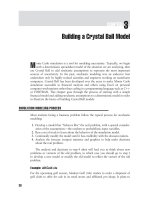Managerial decision modeling with spreadsheets by stair render chapter 01
Bạn đang xem bản rút gọn của tài liệu. Xem và tải ngay bản đầy đủ của tài liệu tại đây (185.83 KB, 14 trang )
Chapter 1:
Introduction to Managerial
Decision Modeling
© 2007 Pearson Education
What is Decision Modeling?
A scientific approach to managerial decision making
•
The development of a (mathematical) model of a real-world scenario
•
The model provides insight into the solution of the managerial problem
Types of Decision Models
•
Deterministic Models
Where all the input data value are known with
complete certainty
•
Probabilistic Models
Where some input data values are uncertain
Quantitative vs. Qualitative Data
The modeling process begins with data
•
Quantitative Data
Numerical factors such as costs and
revenues
•
Qualitative Data
Factors that effect the environment which are
difficult to quantify
Spreadsheets in Decision Making
•
Computers are used to create and solve models
•
Spreadsheets are a convenient alternative to specialized software
•
Microsoft Excel has extensive modeling capability via the use “add-ins”
Steps in Decision Modeling
1.
Formulation
Translating a problem scenario from words to a mathematical model
2.
Solution
Solving the model to obtain the optimal solution
3.
Interpretation and Sensitivity Analysis
Analyzing results and implementing a solution
Steps in
Modeling
Example Model: Tax Computation
Self employed couple must estimate and
pay quarterly income tax (joint return)
•
Income amount is uncertain
•
5% of income to retirement account, up to $4000 max
•
Personal exemption = 2 x $3200 = $6400
•
Standard deduction = $10,000
•
No other deductions
Tax Brackets
Taxable Income
up to $14,600
$14,601 to $59,400
$59,401 to $119,950
Percent of
Taxable Income
10%
15%
25%
Example Model: Break-Even Analysis
Profit = Revenue – Costs
Revenue = (Selling price) x (Num. units)
Costs = (Fixed cost) +
(Cost per unit) x (Num. units)
The Break Even Point (BEP) is the number of units where;
Profit = 0, so
Revenue = Costs
BEP
=
Fixed cost
(Selling price) – (Cost per unit)
Possible Problems in
Developing Decision Models
Defining the Problem
•
Conflicting viewpoints
•
Impact on other departments
•
Beginning assumptions
•
Solution outdated
Possible Problems in
Developing Decision Models
Developing a Model
•
Fitting the textbook models
•
Understanding the model
Acquiring Input Data
•
Using accounting data
•
Validity of data
Possible Problems in
Developing Decision Models
Developing a Solution
•
Hard to understand mathematics
•
Limitations of only one answer
Testing the Solution
Analyzing the Results
Implementation









